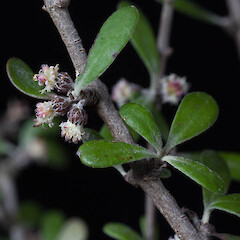Olearia fimbriata
Synonyms
None (firsted described in 1998)
Family
Asteraceae
Flora category
Vascular – Native
Endemic taxon
Yes
Endemic genus
No
Endemic family
No
Structural class
Trees & Shrubs - Dicotyledons
Chromosome number
2n = 108
Current conservation status
The conservation status of all known New Zealand vascular plant taxa at the rank of species and below were reassessed in 2017 using the New Zealand Threat Classification System (NZTCS) – more information about this can be found on the NZTCS website. This report includes a statistical summary and brief notes on changes since 2012 and replaces all previous NZTCS lists for vascular plants.
Please note, threat classifications are often suggested by authors when publications fall between NZTCS assessment periods – an interim threat classification status has not been assessed by the NZTCS panel.
- Conservation status of New Zealand indigenous vascular plants, 2017 . 2018. Peter J. de Lange, Jeremy R. Rolfe, John W. Barkla, Shannel P. Courtney, Paul D. Champion, Leon R. Perrie, Sarah M. Beadel, Kerry A. Ford, Ilse Breitwieser, Ines Schönberger, Rowan Hindmarsh-Walls, Peter B. Heenan and Kate Ladley. Department of Conservation. Source: NZTCS and licensed by DOC for reuse under the Creative Commons Attribution 4.0 International licence.
2017 | Threatened – Nationally Vulnerable | Qualifiers: PD, RF
Previous conservation statuses
2012 | Threatened – Nationally Vulnerable | Qualifiers: PD, RF
2009 | Threatened – Nationally Vulnerable | Qualifiers: PD, RF
2004 | Serious Decline
Brief description
Rare small tree bearing many erect branches that are squareish in cross-section and with clusters of dark green leaves that are white underneath inhabiting eastern South Island valleys. Leaves 10-17mm long by 4-6mm wide. Flowers small, body has hair-edged scales (lens needed). Seeds fluffy.
Distribution
Endemic. South Island (Canterbury, Otago, and Southland).
Habitat
Lowland to montane shrubland, alluvial flats, and among shattered rocky outcrops.
Detailed description
Semi-deciduous shrub or small tree up to 8 m tall; multistemmed or with a single trunk up to 500 mm diameter. Branchlets 4-angled, pale grey or brown, brachyblasts up to 7 × 2 mm. Leaves of adults opposite or in fascicles on brachyblasts; lamina 10–17 x 4–6 mm, elliptic, broadly elliptic to obovate, dark green above, lower surface tomentose with loose and dull hairs, margin entire, apex obtuse to subacute. Inflorescence solitary or in fascicles of 2–5 capitula on brachyblasts, capitula 4 × 4 mm, sessile or peduncles up to 1 mm long. Involucral bracts 16–25, in 3 series, 1.0–1.5 mm long, lanceolate, apex obtuse or subacute, margins with dense white spreading hairs, surface more or less glabrous. Ray florets 5, 3.0–3.5 mm long, limb 0.5 mm long. Disc florets 8, 3.0–3.5 mm long, corolla lobes 0.5–0.8 mm long, tube 2 mm long, pubescent in a ring just below throat with stiff antrorse hairs and a few hairs on corolla lobes. Achenes 1.0–1.5 mm long, narrow obovate, clad in very short, sparse, stiff antrorse hairs; pappus hairs 2 mm long.
Similar taxa
O. fimbriata is most easily distinguished from the other small-leaved Olearia species by its elliptic to obovate and dark green leaves and the involucral bracts that have a distinct fringe of hairs and a usually glabrous lower surface. The most similar species is O. odorata, but this is distinguished by leaves that are linear-obovate and with cuneate bases, involucral bracts that are viscid and covered with sessile glandular hairs only, and the corolla having short, sparse and glandular hairs.
Flowering
January–February
Flower colours
Cream, Yellow
Fruiting
January–March
Propagation technique
Easily grown from fresh seed and semi-hardwood cuttings. Bets in a sunny, well drained situation. Dislikes humidity.
Threats
Although widespread this species is often known from scattered individuals over large parts of its range and at few sites it is actively regenerating. Very few sites are protected.
Etymology
olearia: Named after Johann Gottfried Olearius, a 17th-century German scholar, writer of hymns and author of Specimen Florae Hallensis
Where To Buy
Not commercially available
Additional information
Fact sheet about Olearia fimbriata written by the Department of Conservations Olearia Recovery Group
Attribution
Fact Sheet prepared for the NZPCN by P.J. de Lange 14 April 2006. Description by P.B Heenan (adapted from Heads (1998) and subsequently published in de Lange et al. (2010)).
References and further reading
de Lange, P.J.; Heenan, P.B.; Norton, D.A.; Rolfe, J.R.; Sawyer, J.W.D. 2010: Threatened Plants of New Zealand. Canterbury University Press, Christchurch.
Heads, M. 1998. Biodiversity in the New Zealand divaricating tree daisies: Olearia sect. nov. (Compositae). Botanical Journal of the Linnean Society 127(3): 239-285.
NZPCN Fact Sheet citation
Please cite as: de Lange, P.J. (Year at time of access): Olearia fimbriata Fact Sheet (content continuously updated). New Zealand Plant Conservation Network. https://www.nzpcn.org.nz/flora/species/olearia-fimbriata/ (Date website was queried)



















